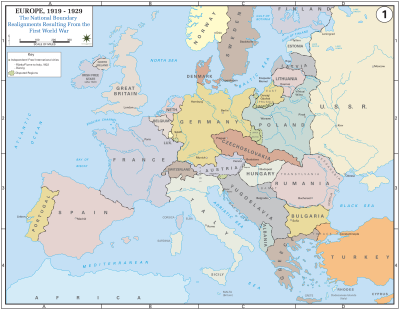
World War One Changed the Map
We sometimes think of countries’ names and national borders as being quite stagnant, but they are constantly changing. The map of Europe today looks more like the map of 1914 than it did the year I was born. Conversely, the 1914 map of the Middle East looks radically different.
Europe Changes and Back Again
Europe’s map was drastically altered by the fighting and bloodshed of World War I. Prior to the war, however, it looked quite similar to today’s map with a few exceptions.
- The Austrian-Hungarian empire was replaced by Austria, Hungary and Czechoslovakia. A portion of the empire also became a section of Yugoslavia.
- Poland is formed.
- The Russian Empire becomes the USSR.
After the war, the map went through significant changes because ethnic groups demanded the right to rule themselves.
More recently, after the fall of communism, the European landscape changed yet again. The nations of Serbia, Montenegro, Latvia, Lithuania and Estonia, which ceased to exist in the years following the war, were reborn. Germany, divided since the Second World War, was again united.
And while Austria-Hungary and the Russian Empire did not return, Czechoslovakia and Yugoslavia ceased to exist. Russia returned in a new form. While still the largest nation on earth, Russia is smaller than the old empire.
This video shows the map of Europe changing between 1914 and 1919.
The Middle East Divided
The map of the Middle East, meanwhile, was changed not by the fall of kingdoms but by colonialism and the Treaty of Versailles that ended the war in 1919.
Arabs fought for the Allies against the Ottoman Empire because they had been given the promise of self rule. The Europeans had no intention of following through. In 1916, Britain and France established two mandates in the region, one for each nation. France received Lebanon and Syria, while Britain received Transjordan, Palestine and Iraq.
Francois Georges-Picot and Mark Sykes, representing the French and British governments, literally drew a line on the map.
“Sykes and Picot were quintessential ’empire men’,” BBC News says. “Both were aristocrats, seasoned in colonial administration, and crucially believers in the notion that the people of the region would be better off under the European empires.”
During treaty negotiations, the larger Allied powers created Middle Eastern countries and African colonies that ignored ethnic groups and regional preferences. The Arabs and many other groups had little, if any, say in the matter.
European partition of the Middle East is blamed for the instability experienced in the region today. Some have made the argument that the war never did end.
Where to Purchase the WWI Trilogy
This post is a companion piece to Melina Druga’s WWI Trilogy: Angel of Mercy, Those Left Behind and Adjustment Year. The trilogy focuses on Hettie and her family as they navigate the challenges and heartbreak World War I brings.
Angel of Mercy: A nurse reluctantly sacrifices her career for marriage. An impending war will change her, and her husband’s, life forever. Available in eBook, paperback and hardcover. Click here for a full list of retailers.
Those Left Behind: The brewing winds of war will soon rip the family apart. Available in eBook, paperback and hardcover. Click here for a full list of retailers.
Adjustment Year: A war nurse returns home. Society expects her to carry on as if the Great War never happened. But how can she? Available in eBook, paperback and hardcover. Click here for a full list of retailers.
